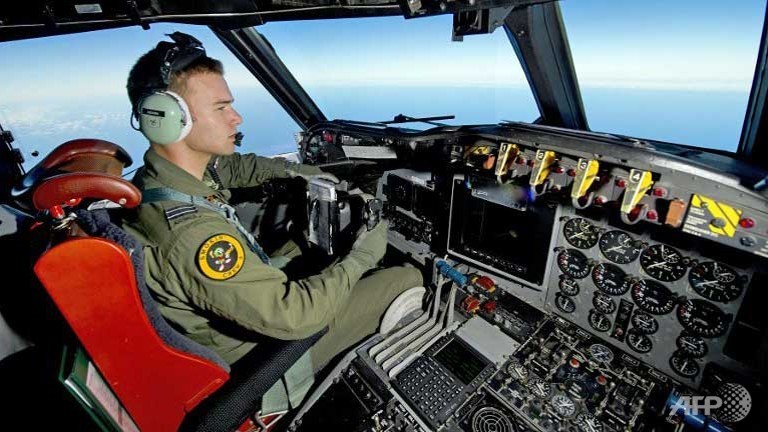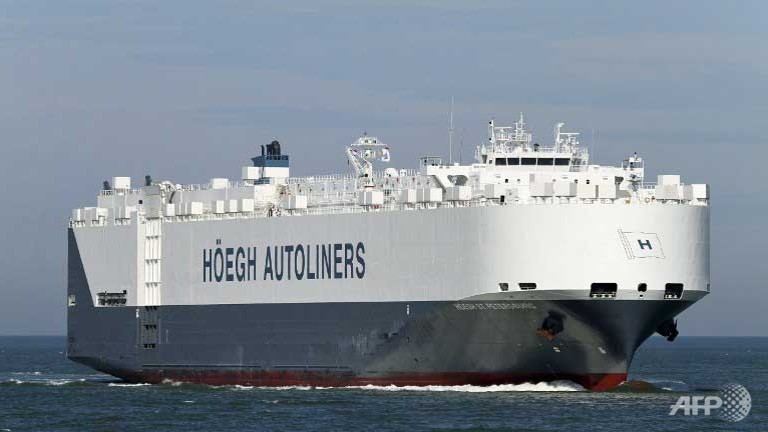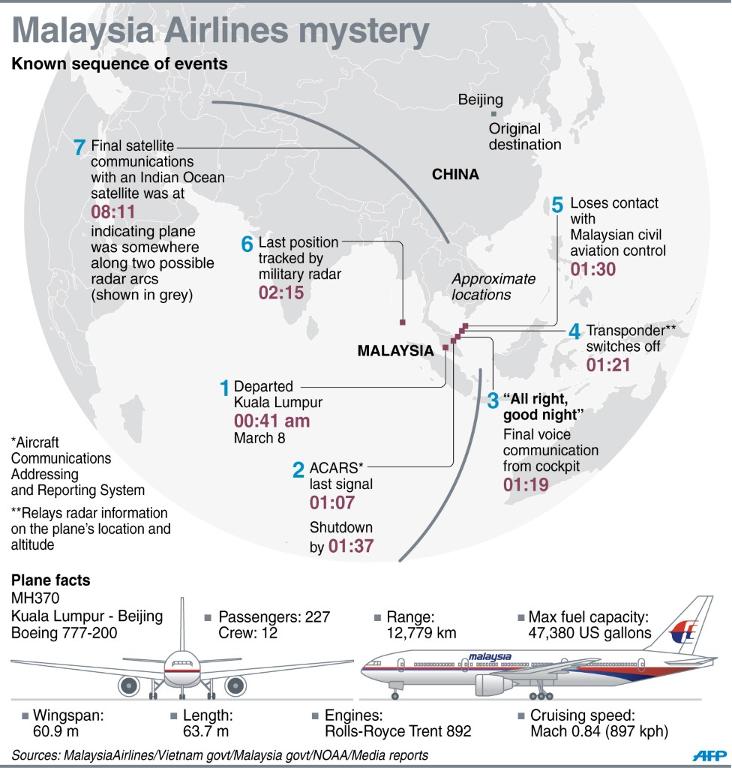Australia resumes ocean search for possible plane debris

A Royal Australian Air Force pilot flying his AP-3C Orion over the southern Indian Ocean during the search for missing Malaysian Airlines flight MH370. (AFP/AUSTRALIAN DEFENCE/SGT HAMISH PATERSON)
>> Bad weather hampers search for possible MH370 plane debris
CANBERRA: Australia prepared to resume its search on Friday for possible plane wreckage floating in a remote and stormy section of the Indian Ocean, as the vast international hunt for a missing passenger jet entered its 13th day.
Surveillance aircraft on Thursday searched for a pair of floating objects captured by satellite imagery, which Australia and Malaysia guardedly called a "credible" lead in the baffling mystery surrounding missing Malaysia Airlines Flight 370.
The Australian-led search was due to restart at first light, as a Norwegian merchant ship arrived in the target area about 2,500 kilometres (1,500 miles) southwest of Perth, after warnings of poor weather conditions and limited visibility.
Four aircraft suspended their search at nightfall Thursday without any sighting of the possible debris after scouring a 23,000-square-kilometre (8,900-square-mile) area where the grainy images were snapped, the Australian Maritime Safety Authority said.
Two planes came from Australia, one from New Zealand and one was a US aircraft, while another merchant ship was en route to join Norway's Hoegh St Petersburg merchant ship.
The Australian navy's HMAS Success was also headed for the area, and Britain sent a naval survey ship, HMS Echo.
Australia said the satellite-captured objects -- the largest was estimated at 24 metres (79 feet) across -- raised hopes of a breakthrough in the Malaysian plane's mysterious disappearance as relatives of the 239 people aboard braced for another emotional roller-coaster.
"We now have a credible lead," Minister for Defence and Acting Transport Minister Hishammuddin Hussein said during Malaysia's daily briefing on the crisis.
"There remains much work to be done to deploy the assets."
Clearly wary of raising hopes following a series of past false leads, Hishammuddin warned of delays in verifying the apparent debris.

The Norwegian ship "Hoegh St Petersburg", which was asked by Australia to assist in the search for the missing Malaysia Airlines Flight MH370. (AFP/SCANPIX NORWAY/HOEGH AUTOLINERS)
The Malaysia Airlines Boeing 777, carrying 227 passengers and 12 crew, vanished in the early hours of March 8 after veering drastically off course over the South China Sea while en route to Beijing.
Investigators say it was deliberately diverted but still don't know by whom, why or where it ended up.
The satellite images, taken on Sunday, were first revealed by Australian Prime Minister Tony Abbott.
Abbott told parliament the images represented "new and credible information" but stressed that any link with flight MH370 had still to be confirmed.
"The indication to me is of objects that are of a reasonable size and probably awash with water and bobbing up and down over the surface," top AMSA official John Young said.
The images are the first solid clue since the search area was significantly broadened last weekend to take in a vast part of the Indian Ocean.
Experts said the fact that Abbott himself had released the information lent weight to its credibility, but warned it could be difficult to find the objects in an isolated corner of the Earth noted for strong currents.
"The current there is one of the strongest in the world, moving at as fast as one metre per second," said Gan Jianping, an oceanographer at the Hong Kong University of Science and Technology.
HMAS Success, which is capable of retrieving any debris, is some days away from the site.
The objects would have drifted for four days, making them a "logistical nightmare" to locate, said Australian Defence Minister David Johnston.
"We are in a most isolated part of the world. In fact it probably doesn't get, if I can be so bold, more isolated," Johnston told Sky News Australia.
He was later quoted as saying it could take "two or three days" before any firm conclusions are made.
The search time for any aircraft is restricted by the roughly six-hour round-trip flight to the area, said Caj Frostell, a former official with the International Civil Aviation Organisation.
"Your time of search is fairly limited because you need to have fuel to get back. That's why they need to have ships there also," he said.
Malaysia has been under increasing fire for an investigation and search viewed as disjointed and chaotic, especially from passengers' relatives, who accuse authorities and the flag-carrier airline of insufficient or misleading information.
Nearly two thirds of the passengers were Chinese nationals.
There was a mixed reaction to the news among families gathered at a Beijing hotel, who have clung for almost two weeks to slim hopes that the plane landed somewhere.
"My son is still alive. My son is still alive. I don't believe the news," cried Wen Wancheng, 63, as he pushed his way through a throng of reporters.
Others cited the previous sightings that went nowhere.
"I am sick of hearing there is new information only for it to be dismissed later," one man told AFP angrily.
There were chaotic and emotional scenes in Malaysia on Wednesday, when a group of angry Chinese relatives tried to gatecrash the government's tightly controlled daily media briefing.
Malaysian security personnel bundled them away.
If debris is found, the new and challenging task will begin of finding the black box to help figure out what befell the plane.
Malaysia has asked the FBI to help recover data it said was deleted from a home flight simulator belonging to the plane's chief pilot, Captain Zaharie Ahmad Shah.
Zaharie, a respected 33-year veteran of the airline, has come under suspicion since investigators concluded the plane's communication systems were disabled manually before it changed course.

What the stars mean:
★ Poor ★ ★ Promising ★★★ Good ★★★★ Very good ★★★★★ Exceptional
Latest News
More News
- Thailand seeks to promote digital training (November 04, 2024 | 16:14)
- Indonesia attracts foreign investment in technology sector (November 04, 2024 | 16:08)
- Tropical storm Trami leaves at least 24 people dead in Philippines (October 24, 2024 | 17:36)
- Singapore grants conditional approval for solar power import from Australia (October 24, 2024 | 17:27)
- ASEAN digital economy set to reach $2 trillion by 2030 (October 22, 2024 | 15:08)
- Thailand asks Laos to waive visa fee at border checkpoints to boost tourism (October 21, 2024 | 17:23)
- Laos pledges to continue efforts to empower girls (October 21, 2024 | 17:17)
- Chinese electric vehicle maker to build plant in Indonesia (October 21, 2024 | 17:12)
- Vietnam Elevator Association introduces Elevator Safety Application to the world (October 18, 2024 | 09:00)
- A taste of the future - the go-to spot at the Worldchefs Congress & Expo 2024 (October 15, 2024 | 16:11)




















 Mobile Version
Mobile Version